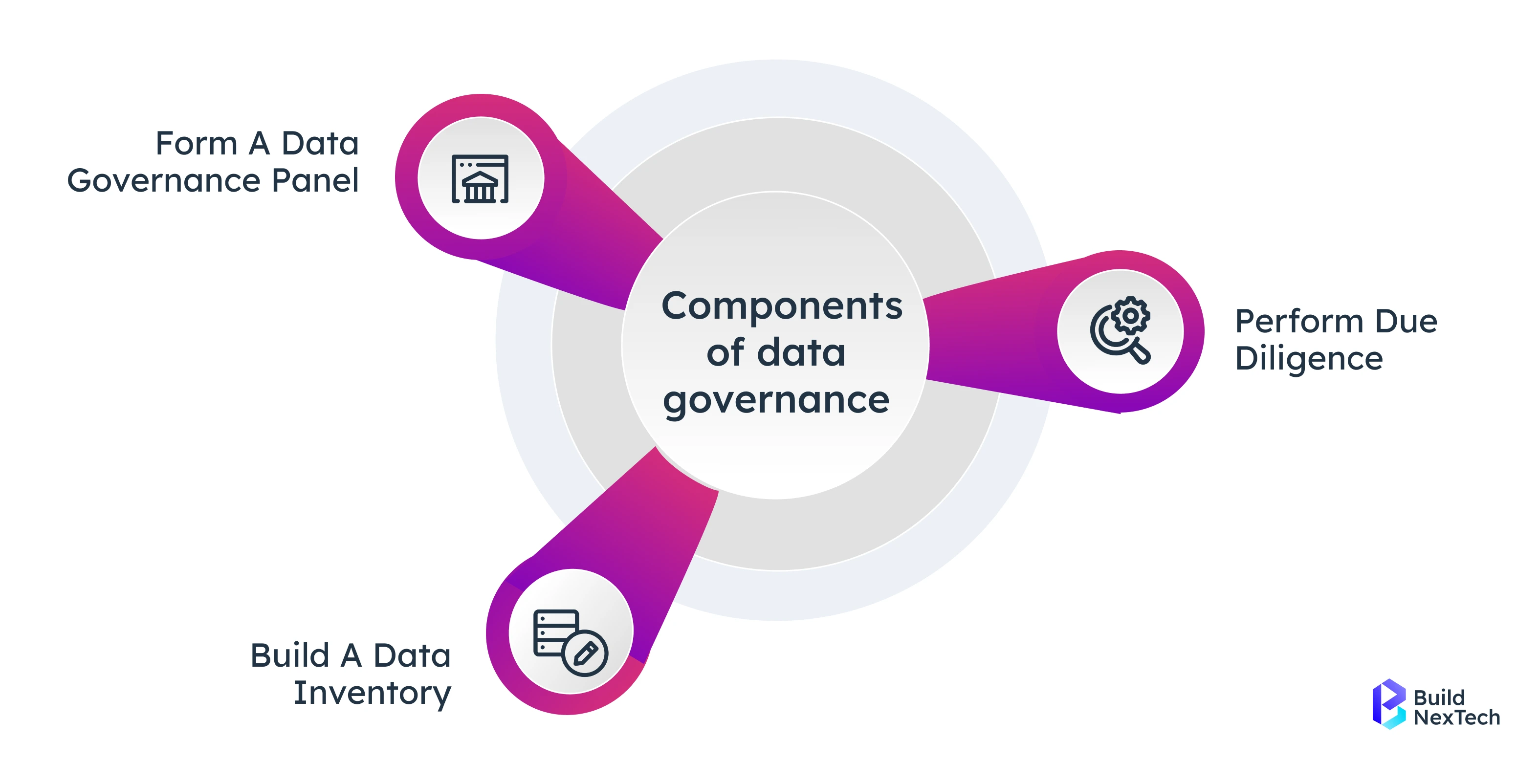Enterprises with complex systems and growing data must balance innovation, security, and scalability throughout transformation. In today’s rapidly evolving digital landscape, success depends on how efficiently organisations modernise their systems without compromising stability.
At BuildNexTech, a trusted digital transformation partner, we help enterprises with complex data systems modernise securely and efficiently. Our data engineering solutions ensure smooth data flow, governance, and scalability across enterprise transformation initiatives. In today’s rapidly evolving digital landscape, success depends on how efficiently organisations modernise their systems without compromising stability.
✨ Key Insights from This Article:
🧠 Understand how digital transformation enhances scalability, governance, and innovation.
⚙️ Learn how data engineering powers reliable data pipelines and analytics.
💡 Discover how modern frameworks accelerate enterprise performance.
🔐 See how structured development prevents errors and ensures system stability.
🚀 Gain insights into how BuildNexTech helps enterprises achieve sustainable digital growth.
Understanding Digital Transformation
What is Digital Transformation?
Digital transformation redesigns how enterprises deliver value. It automates tasks, adds analytics, and builds systems that grow. This helps keep innovation going.
- Automation replaces repetition, improving efficiency and reducing human error.
- Analytics powers data-driven insight for timely business actions.
- Scalable ecosystems enable innovation across departments and large-scale applications.
Digital transformation drives clarity, consistency, and governance in enterprise business operations through its established patterns of structured data workflows, validated systems, and governed pipelines that provide scalability and reliability. Digital transformation creates collaboration and accountability across teams so that innovation and sustainable enterprise growth occurs within a cohesive framework.
Digital Transformation: Meaning and Importance
Digital transformation is more than a new tool; it is a complete change in how the organization thinks and operates. It ties workflows, decision-making, and agility to business outcomes you can measure.
- Mindset vs mechanics – leadership with vision leads to adaptation to change.
- Agility and innovation – faster response of teams to new technology and changing markets.
- Data-informed outcomes – the decisions made in the organization can be viewed, and we all have the same clarity and verification on how we're reaching that informed decision.
The same system integrity that helps to prevent execution errors means that the governance we have is contributing to effective business efficiency. Basically by leveraging enhanced data monitoring, cloud platform scaling, and validation frameworks, organizations can identify inefficiency earlier and more efficiently maintain safe scalability across all enterprise data systems.
Why Digital Transformation?
Organizations undertake digital transformation for the purposes of resiliency, in rapidly evolving markets, shifting customer expectations, and disruptive technological shifts. Digital transformation is more than an upgrade to your existing systems; it is the construction of smarter, adaptive and data-driven ecosystems.
- Market evolution - you must be innovating at all times to remain competitive, while also gaining competitive advantage through emerging technologies.
- Customer expectations - Customers expect experiences that are faster, personalized, and automated, all in a seamless digital platform.
- Innovation cycles - Agility and adaptability allow you to scale your organization quickly and respond effectively to changes occurring in the business environment.
Modern data engineering frameworks, data pipelines, and cloud-native architectures can ensure data flows freely and systems interoperate across the enterprise. They can also help you create a single, unified, scalable framework for integrating analytics, automation, and governance.
The Role of Data Engineering in Digital Transformation
What is Data Engineering?
Data engineering is at the core of any digital transformation. To illustrate, it functions like a compiler; it validates, or structures and logically connects, data pipelines, generating flow and trustworthiness across systems and enterprise systems.
In Data Engineering, your organization can capitalize on a number of ways to validate data integrity and enhance trust:
- Rule-based validation – enables data integrity based on well-defined schemas, type checks, and data models that ensure data integrity before reaching analytic stories and reporting layers.
- Error prevention – helps identify anomalies and runtime bugs earlier by using patterns that include automation and data refactoring tools that ensure systems remain stable as you scale them.
- Transparent architecture – develops governed data contracts and metadata-driven pipelines that help maintain consistency across data systems and integrations.
- Smarter decision-making – enables the organization to develop data-driven strategies in which structured and validated data feeds analytics, reporting, and predictive characteristics.
- Scalable data flow – enables cloud-based data pipelines and extraction, transformation, loading (ETL) frameworks to help manage more effectively across varied sources.
As a trusted data engineering partner, BuildNexTech is responsible for building and maintaining the modern data systems that will provide reliable analytics, seamless integration, and governed scalability that provide an enterprise's digital transformation efforts with an engineered backbone.

H3 - Importance of Data Engineering Solutions
Data engineering defines the foundation for reliable data flow.
- Blueprint for transformation – ensures consistent data flow, seamless analytics integration, and scalable data systems.
- Precision through validation – enforces data quality checks, schema validation, and early anomaly detection.
- Governed analytics – improves data governance, API integration, and overall data consistency.
- Structured data discipline – governed architectures enhance visibility, traceability, and prevent data bottlenecks.
As a data engineering partner, BuildNexTech ensures reliable data flow and actionable analytics for enterprise success.

Digital Transformation Services and Solutions
BuildNexTech leads digital transformation with clear data workflows and modern data engineering practices. Recognised as a leading digital transformation company, we deliver scalable and governed enterprise solutions.
These digital transformation solutions align technology, governance, and data systems for predictable performance.
- Structured development – powered by automated data validation, governed frameworks, and well-defined data models.
- Governed automation – enhances data flow consistency, API integration, and system reliability.
- Scalable data systems – enable secure analytics platforms, cloud pipelines, and enterprise applications.
Every project uses safe refactoring practices that maintain data accuracy and keep large applications predictable. BuildNexTech provides comprehensive digital transformation services that combine automation, analytics, and scalability for enterprise growth.
Key Components of Digital Transformation
Digital Transformation Model
A digital transformation model defines the structural blueprint for how technology, data, and processes interact across the enterprise. It acts as the foundation for aligning business objectives with scalable, modular, and automated digital systems. A robust transformation model acts like a modular data and digital ecosystem with reusable components. This digital transformation framework ensures modularity, scalability, and predictable system performance.
- Modular integration – cloud, automation, and governed data pipelines unify enterprise systems.
- Error prevention – data validation and governance prevent inconsistencies and ensure predictable data workflows.
- Optimization & clarity – governed data models and standardized frameworks enhance visibility and scalability.
Well-defined data interfaces give structure while allowing flexibility for integration and user needs.
Digital Transformation Process
The digital transformation process outlines the practical steps an organisation takes to modernise its systems, automate workflows, and improve efficiency. It connects strategy to execution through data pipelines, automation, and cloud integration. Transformation starts by identifying inefficiencies in systems and data flow, then uses automation to resolve them efficiently.
- Assess bottlenecks – locate data flow issues and optimize pipelines for efficiency.
- Build pipelines – ensure efficient data movement across large-scale enterprise systems.
- Automate workflows – increase scalability with browser scripting tools and IDE support.
With advanced digital transformation technologies, teams gain improved visibility, faster decision-making, and stable data systems.
Integrated cloud platforms and governed data systems streamline operations and enable seamless enterprise-wide connectivity.
Digital Transformation Business Model
A digital transformation business model describes how enterprises create value using technology, data, and innovation. It focuses on sustainable growth, customer experience, and operational efficiency through digital ecosystems. Digital business models focus on growth through data engineering, automation, and cloud-driven innovation.
- Cloud & SaaS adoption – secure cloud platforms, governed data systems, and scalable data pipelines enhance performance.
- Modular architecture – integrates analytics, APIs, and automation into a unified digital transformation framework.
- Error-free culture – governed validation and data quality checks prevent inconsistencies across systems.
These models combine governed analytics, collaboration, and automation to create a secure, data-driven enterprise ecosystem.
Strategies for Successful Digital Transformation
Developing a Digital Transformation Strategy
A solid digital transformation strategy is like defining a clear data architecture—structured, measurable, and scalable.
- Set measurable KPIs – define outcomes using data-driven metrics that track performance, efficiency, and scalability.
- Apply governance – ensure strict validation, data accuracy, and consistency across enterprise systems.
- Use Microsoft-backed tools – Leverage modern data engineering tools and platforms to enable automation, analytics, and reliable data pipelines.
- Optimise scalability – improve data flow, system reliability, and enterprise-wide performance.
This ensures governed data systems, simplified process adoption, and long-term scalability. A clear digital transformation roadmap helps teams align strategy, execution, and measurable outcomes.
Strategy for Digital Transformation Initiatives
Large enterprises need a connected digital transformation strategy where data systems, platforms, and teams work seamlessly together.
- Integrated architecture – aligns data pipelines, APIs, and analytics frameworks for real-time performance.
- Enterprise refactoring – applies data validation, schema alignment, and automated quality checks.
- Tool-driven scalability – advanced data engineering tools and cloud platforms accelerate data processing and scalability.
- Performance synergy – enhances data flow efficiency, governance, and system stability across digital platforms.
Companies that use this approach strengthen data-driven decision-making, improve operational efficiency, and deliver better digital experiences.
Corporate Digital Transformation
Corporate digital transformation is like migrating from siloed systems to unified data frameworks — ensuring disciplined change and governed scalability across business units.
- Cultural shift – upskill teams to adopt data-driven practices, analytics tools, and governed data workflows.
- Governance alignment – consistent data standards ensure compliance, transparency, and enterprise-wide predictability.
- System refactoring – removes legacy data bottlenecks and streamlines data pipelines across departments.
- Collaborative ecosystem – enhances cross-functional collaboration, ensuring seamless data flow and sustainable enterprise scalability.
It integrates disciplined data engineering practices, validation, and structured workflows across departments for consistent transformation success.
Emerging Trends in Digital Transformation
AI, edge computing, and data engineering solutions redefine how enterprises scale digital systems and enhance secure innovation. These digital transformation technologies enable seamless data integration, intelligent automation, and secure enterprise scalability. Digital transformation frameworks ensure modular design, governed workflows, and efficient integration between cloud, analytics, and automation layers.
- Smarter builds – automated data pipelines and cloud-native orchestration simplify integration, testing, and deployment.
- Enhanced performance – edge analytics and API optimisation deliver real-time processing and seamless user experiences.
- Structured scalability – governed architecture and modular data layers ensure predictable performance and system scalability.
- BuildNexTech advantage – as a digital transformation partner, it combines data-driven strategies, AI automation, and cloud engineering for long-term scalability.

What Digital Transformation Means for Business
Digital transformation is about readiness — the ability to create adaptive data systems that change with changing technology. Scalability goes up by removing bottlenecks with data pipelines and a governed digital transformation framework. Reliability goes up through established data flow, automation, and ongoing monitoring, which assures system performance. A combination of modern data engineering tools with automation frameworks supports much quicker iteration and deployment cycles. Solid governance with well-formed data models and structured frameworks delivers enterprise-wide consistency and reliability.
Digital Business Transformation Strategy
A holistic strategy unites API calls, analytics, and frameworks into a governed ecosystem.
- Data engineering mindset – reusable data pipelines and predictable workflows ensure consistent data flow.
- Readability and structure – mirrors well-defined data models and transparent data systems in enterprise environments.
- Rule enforcement – ensures data validation, compliance, and consistency across the digital transformation framework.
- Future-ready foundation – delivers predictable performance through governed analytics and scalable architecture.
Our team of digital transformation experts helps enterprises connect data, automation, and technology for measurable growth.
Conclusion
Digital transformation represents more than an upgrade; it's a change in thinking about your business that allows enterprises to innovate, scale and become resilient in changing markets. This blog has echoed that success is built on establishing governed data systems, structured frameworks, and data pipelines that connect technology, people, and processes. Data engineering, which ensures every spontaneous data flow, analytics model, or automated system expediting machine learning, is foundational to this evolution. Your business now has access to greater precision, consistency, and measurable business outcomes than ever.
At BuildNexTech, we combine rigorous engineering with strategic digital transformation consulting – energizing enterprises to modernize in a secure and efficient manner. Our governed data workflows, automation frameworks, and scalable architectures are the building blocks of sustained innovation. In partnership, we empower businesses to take their vision to execution – leading to sustained growth, governance and resilience in the digital marketplace.
People Also Ask
How is success in digital transformation measured?
Success is tracked through KPIs like scalability, efficiency, and customer experience improvements that reflect measurable business growth.
What are the biggest challenges in digital transformation?
Legacy systems, data silos, and resistance to change often slow progress, but refactoring tools and clear governance frameworks help overcome them.
How long does a digital transformation process take?
Timelines vary by scale and complexity, typically progressing in structured phases to ensure stability and scalability.
Which industries benefit the most from digital transformation?
Manufacturing, healthcare, BFSI, SaaS, and mobility sectors benefit most through automation, analytics, and process optimization.


























.webp)
.webp)
.webp)

